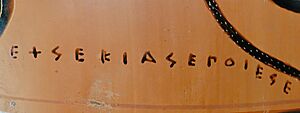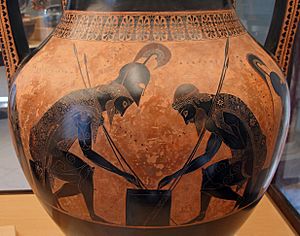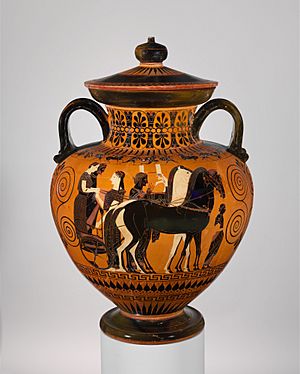Exekias facts for kids
Quick facts for kids
Exekias
|
|
|---|---|
| Born |
Exekias
before 550 BC Probably Athens
|
| Died | About 525 BC |
| Nationality | Greek |
| Known for | Vase painting |
|
Notable work
|
High-quality vases for export and home consumption |
| Movement | Black-figure style, Group E |
Exekias (Ancient Greek: Ἐξηκίας, Exēkías) was a famous ancient Greek artist. He painted and made pottery in Athens around 545 to 530 BC.
He mostly used the "black-figure" style. This meant painting designs with a special black clay paint. He would then scratch in details to show things like hair or patterns.
Art experts think Exekias was a true art genius. His detailed work and emotional scenes make him one of the best vase painters from Athens. Some believe the Andokides painter and the Lysippides Painter were his students.
Contents
The Art of Exekias
Exekias's artworks are special because of their new designs and careful drawing. He also showed feelings in his characters, which was hard to do with the black-figure style.
John Boardman, a famous Greek art historian, said Exekias's style had a "statuesque dignity." This means his vase paintings looked as grand as statues.
Exekias was a very creative artist. He loved trying new things. He made new vase shapes and even used a special "coral-red" paint to add more color to his works.
We know of fourteen artworks signed by Exekias. Many more are thought to be his based on their style. His signed pieces help us understand how ancient pottery workshops worked.
Most of his signed works say "Exekias made [me]" (epoíēsen). Only two say "Exekias made and painted me" (égrapse kapoíēsé me). This suggests he was proud of these two pieces, or perhaps he was the workshop boss.
Where Exekias's Vases Were Found
The places where Exekias's vases were found tell us about his customers. Some pieces were found on the Athenian Acropolis. This shows he had buyers in his home city of Athens.
Finding his vases on the Acropolis, a religious place, proves how respected he was. Exekias also sold many vases outside Athens. Many of his works were sent to Etruria in Italy.
These vases were found in Etruscan tombs. The Etruscans admired Greek art. Over 30,000 Greek vases have been found in their region. This shows that people far away also loved Exekias's art.
Group E and Exekias
Art expert John Beazley believed Exekias started his career with a group of artists called "Group E." He thought Exekias learned from them and then became even better.
Group E made art that was similar to Exekias's style. They also broke away from older pottery traditions. Group E is known for creating new, elegant vase shapes, like the "Type A amphora".
Exekias was the only artist in Group E who signed his work. This might mean he was the one who developed these new shapes. Group E artists often painted similar stories. These included the birth of Athena and the hero Herakles fighting monsters.
Types of Vases Exekias Made
Exekias did not focus on just one type of vase. He made many different kinds. These included neck amphorae, Type A and B amphorae, and drinking cups.
He also made large mixing bowls called kraters and water jars called hydriai. One of his most unusual works is a set of funeral plaques found in Athens. These plaques showed a funeral ceremony. They were likely attached to a tomb.
Famous Themes in His Art
Exekias often re-imagined old myths in his paintings. Sometimes, he even created new trends in art.
The Dionysus Cup
One of his most famous works is the "Dionysus Cup" in Munich. This is a kylix, a type of drinking cup. It has two pairs of eyes painted on the outside. This eye design might have been Exekias's own idea.
The inside of the cup shows the god Dionysus on a ship. The background is a special coral-red color. Dionysus was the god of inspiration. The painting shows his first trip to Athens by ship.
Pirates captured the ship, planning to sell Dionysus as a slave. But the god made vines grow from the mast. This scared the pirates so much that they jumped into the sea. They turned into dolphins, which you can see swimming around the ship.
Exekias was the first Athenian painter to show Dionysus sailing inside a cup. He often chose quiet moments from myths, not the big battles. On this cup, Dionysus is relaxing, not fighting his kidnappers.
Achilles and Ajax Playing a Game
Another famous work is the Vatican amphora 344. Many art experts call this Exekias's masterpiece. It shows the heroes Achilles and Ajax playing a board game. They sit facing each other, looking down at the game board.
The game was like backgammon or checkers and used a die. The words painted next to them say Achilles rolled a four and Ajax a three. Even though they are playing, they are ready for battle. Their armor is nearby, and they hold their spears.
Exekias added small details that make this scene special. Achilles wears his helmet, showing he is more powerful than Ajax. Ajax's heel is slightly lifted, suggesting he is nervous.
This painting shows a quiet, relaxed moment during the Trojan War. It also shows Exekias's amazing skill. The figures of Achilles and Ajax have fine details. You can see patterns on their clothes and almost every hair.
There was no known story about Achilles and Ajax playing a game in books at that time. Exekias might have heard this story from local storytellers. His new painting of them playing became very popular. It was copied over 150 times in the next fifty years.
How Exekias Composed His Art
Exekias often had a main picture on his vases. But he also added interesting details around it. He used beautiful spirals and plant designs to frame his scenes.
Sometimes, the main picture would seem to appear suddenly from a dark background. Exekias used the curved shape of the vase as part of his design. The lines and forms of his paintings fit the vase's curves.
When you look at his vases, your eyes are drawn to the main scene. This could be the game board, a face, or a sword. All the other lines in the painting lead your eye to this main point. For example, the spears of the warriors or the curved backs of their bodies.
He also painted scenes with many figures, like chariots with magnificent horses. Exekias used many clever ways to make his art exciting. This made viewers look closely and admire his fine details.
Exekias's Use of Line
Exekias was also a master of using lines. He drew his figures very finely. He also carefully scratched in details. These details showed hair, beards, and unique faces.
He also added details to armor, furniture, plants, and animals. Most impressive are the patterns on clothes. They are very detailed and precise.
On the famous Vatican amphora (344), Achilles and Ajax wear richly decorated cloaks. You can see almost every pattern clearly, even though they are small. These patterns include stars, swastikas, and loops.
He also skillfully showed muscles, hands, feet, and armor. Hair was drawn with many parallel lines that ended in curls. The faces of the heroes perfectly show their deep focus on the game.
See also
 In Spanish: Exequias (pintor) para niños
In Spanish: Exequias (pintor) para niños
- Pottery of Ancient Greece
- Ancient Greek vase painters
Images for kids




